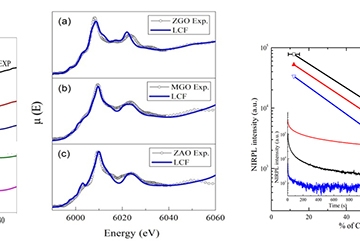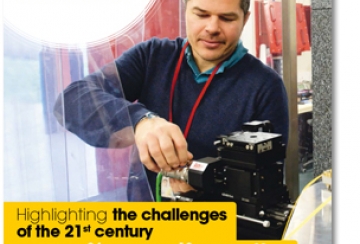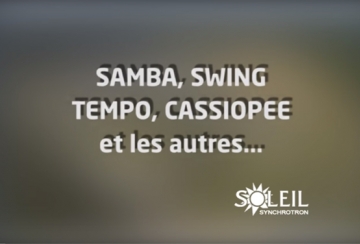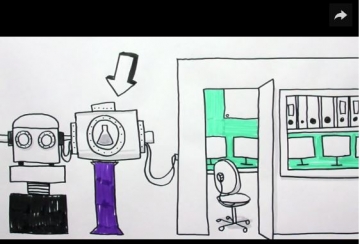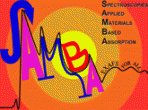
SAMBA (Spectroscopy Applied to Material Based on Absorption) is a hard X-ray absorption spectroscopy (XAS) beamline. SAMBA is open to a broad scientific community spanning from physics to chemistry, surface and environmental sciences.
SAMBA (Spectroscopy Applied to Material Based on Absorption) is a hard X-ray absorption spectroscopy (XAS) beamline. SAMBA is open to a broad scientific community spanning from physics to chemistry, surface and environmental sciences. The design of SAMBA optics is optimized in order to be very versatile and to cover the 4.5-43 keV energy range with a high flux of photons and stability and optimum energy resolution. A new 35 pixels HPGe fluorescence detector is available since 2012 for measurements on highly diluted specimens.
Please note that the Quick-EXAFS device has been transferred to the dedicated ROCK beamline.
Technical data
Between 6 to 35 keV
Si(111) : 1.2x10-4 @ 5 keV
Si(220) : 6x10-5 @ 15 keV
Bending Magnet Radiation (Ec = 8.65 keV) 1.5 mrd Horizontal x 1 mrd Vertical
Si(111) : 10+12 Phot/s/0.1%bw @ 10 keV
Si(220) : 2.8x10+11 Phot/s/0.1%bw @ 15 keV
Si(220) : 2.3x10+10 Phot/s/0.1%bw @ 35 keV
A sagittal focusing monochromator between two bendable cylindrical mirrors
Many ancillary devices like cryostats (He liq and N2liq), furnaces, thermostated liquid cells and many sample-holders.
Raman Spectroscopy
UV-Visible Spectroscopy
Differential Scanning Calorimetry
(x-ray diffraction as a further developement)
200x300 μm2
300x300 μm2
Ionisation chambers (Transmission)
Canberra 35-elements monolithic planar Ge pixel array detector, Multi-elements Germanium detector or a Vortex silicon drift detector (Fluorescence)
Total electron yield

Scientific opportunities
|
Material science Energy storage |
Determination of structural and electronic properties and average size of nanosystems. Dynamic or static study of new anodic or cathodic materials. Understanding of magnetic phase transition of molecular system in coordination chemistry. Characterisation of glasses, Sol-Gel etc... |
|---|---|
| Physic | Investigation of clusters embedded in matrices. |
| Biology, Biomaterials |
Study of reactivity of biomimetic compounds which are used as simple model compounds to understand the mechanism of catalysis of more sophisticated systems like metallo-enzymes. Investigation of metal ions present in metallo-proteins and in bio-inorganic complexes. |
| Earth and environmental sciences |
Local environment probe of any element in natural systems (soils, sediments, snow, plants, microorganisms ...). |
| Surface science |
Characterisation of the local structure of thin films at the very first stages of growth. Study of the interfaces : metal/metal, metal/semiconductor and oxides/metal. |
| Catalysis |
Structural and electronic characterisation of catalysts in order to understand/predict their catalytic activity/selectivity in a given reaction. (DeNOx catalysis, Fischer-Tropsch, hydrogenation of hydrocarbons ...). |
Optical Hutch
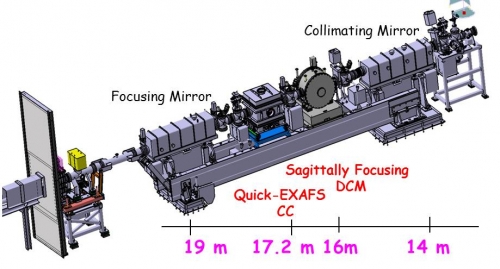
Optical layout
- Mirrors
- Sagittal focusing double crystal monochromator
- Quick-EXAFS monochromator (no longer available)
Mirrors
Two cylindrically bendable silicon mirrors (WinlightX) coated by a layer of 50 nm of Pd are used for providing:
- vertical collimation of the beam
- vertical focusing of the beam at the sample position
- harmonic rejection.
The mirrors are used over the whole 4-40 keV energy range available on the beamline by tilting the mirrors from 10 mrad to 1 mrad (i.e. 0.57° to 0.057°) depending on the desired cut-off energy for removing the harmonic X-rays.

The reflective Pd surfaces are 1200 mm long per 88 mm wide allowing a horizontal acceptance of about 6.2 mrad on the first collimating mirror located at 14.1 m from the source. The surface of the mirrors was polished to a rms roughness less than 3 Ǻ rms and to a longitudinal slope error less than 2µrad rms. The first mirror is water cooled using blades immersed in In-Ga eutectic in grooves in the mirror surface.
The focusing in the vertical direction is ensured by the M2 mirror, the resulting vertical spot size at the sample position is 110 µm (FWHM) with a foot size of about 300 µm.

Sagittal focusing double crystal monochromator
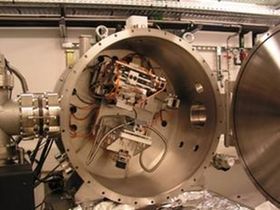
Sagittal focusing double crystal monochromator
Sagittal focusing double crystal monochromator
The sagittally focusing Double Crystal Monochromator (DCM) provided by Oxford Danfysik is used in the so-called high flux mode. The DCM is installed at 16.1 m from the source. It deals of a first flat water-cooled Si(220) or Si(111) crystal and a sagittally bent 2nd crystal. The main Bragg axis of rotation passes through the centre of the diffracting face on the 1st crystal and perpendicular to the beam axis. In this way, the incident white beam is always centred on the axis of rotation. A fixed offset to the exit beam is achieved by moving the 2nd crystal perpendicularly to the first one according to the Bragg angle. In this case the beam moves along the axis of the sagittally-bent 2nd crystal. The first crystal is indirectly water-cooled by using a multi-channel water cooling support (SOLEIL original design) in contact with the crystal through a thin film of In-Ga eutectic. The 2nd crystal is uncooled.
The horizontal acceptance of the monochromator is limited by the efficiency of the sagittal bender. For a horizontal acceptance of 1.5 mrad, the typical beam size at the sample position is around 300 µm (H) x 200 µm (V) (FWHM).
In order to avoid possible radiation damage on the sample due to the high density of photons in a so small spot, the beamline is often slightly defocused in both directions to achieve a spot size of 2 mm (H) x 1mm (V).
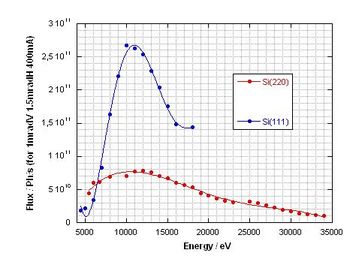
Flux at the sample position provided by the Si(220) and Si(111)
Flux at the sample position provided by the Si(220) and Si(111)
Normalized flux at the sample position for the Si(220) and Si(111) sagittally DCM (400 mA stored current, 1.5 mrad horizontal and 1 mrad of grazing incidence on the mirrors).
Then the typical flux at the sample position at 8.5 keV is 5 1011 ph/s with the Si(220) DCM and 1.2 1012ph/s with the Si(111) DCM (6 mrad of vertical acceptance and 1.5 mrad of horizontal acceptance, I = 400 mA).
Related publications:
SAMBA: The 4-40 keV X-ray Absorption Spectroscopy Beamline at SOLEIL.
V. Briois, E. Fonda, S. Belin, L. Barthe, C. La Fontaine, F. Langlois, M. Ribbens, F. Villain
UVX 2010 - 10e Colloque sur les Sources Cohérentes et Incohérentes UV, VUV et X ; Applications et Développements Récents: 41-47. EDP Sciences 2011
Quick-EXAFS monochromator (no longer available)
The SOLEIL designed Quick-EXAFS monochromators are made of two independent channel-cut crystals (Si(111) and Si(311)). Each channel-cut crystal is mounted on a cam driven tilt table allowing it to oscillate periodically with amplitude θ(t) around an average fixed Bragg angle θB. The amplitude can be tune from 0.1 to 4° by an original SOLEIL in vacuum variable cam design. The θB Bragg angle is selected by one of the two goniometers holding the oscillating tilt tables. The 4 to 37 keV energy range is available using both Quick-EXAFS monochromators. The channel-cut crystal can be changed by the other one in few seconds during an experiment allowing to record quick-EXAFS data at absorption edges very far in energy. For instance the XAS study of a bimetallic catalyst at both edges during the same catalytic reaction is now possible with the SAMBA’s QuEXAFS set-up, even if the edge energies of those elements are covered by two distinct crystals.
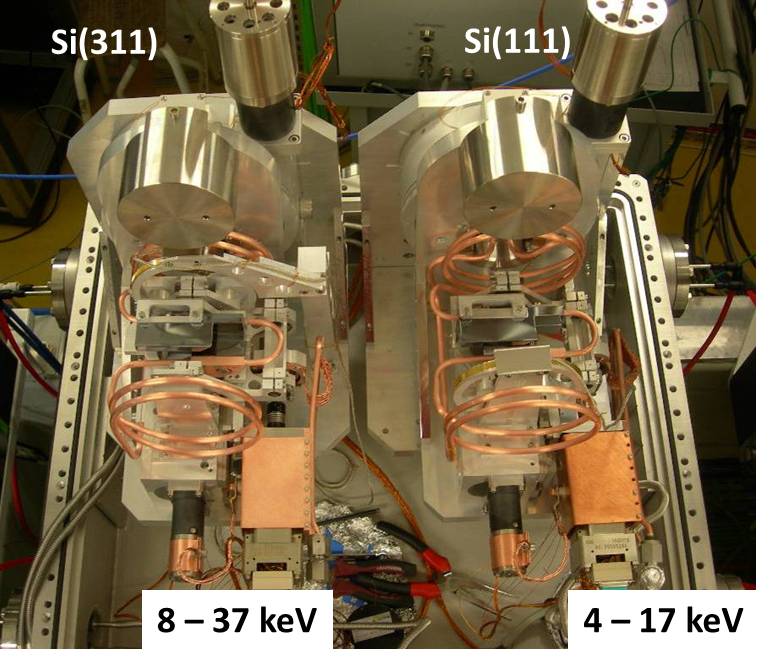 Quick-exafs monochromator
Quick-exafs monochromator
Maximum performance of the Quick-EXAFS mechanics in terms of oscillation frequency of the channel-cut is 40 Hz for two recorded spectra: one with the Bragg angle collection in the downward direction and the other with the Bragg angle collection in the upward direction. Due to the photon flux available at the sample position at the SAMBA beamline in QuEXAFS configuration ((flux ~ 1011 ph/s at 8 keV) the optimal time resolution of experiments on real concentrated and not too absorbing samples is around 100 ms.
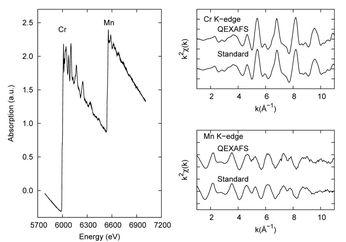
(left) Absorption of stacked Cr and Mn metallic foils measured over an amplitude of 3.6 °. Data are the average of 10 spectra each collected at 1Hz. (right) k2 weighted Quick-EXAFS are compared to standard scans taken in almost 15 min.
(left) Absorption of stacked Cr and Mn metallic foils measured over an amplitude of 3.6 °. Data are the average of 10 spectra each collected at 1Hz. (right) k2 weighted Quick-EXAFS are compared to standard scans taken in almost 15 min.
Related publications:
The SAMBA Quick-EXAFS monochromator: XAS with edge jumping
E. Fonda, A. Rochet, M. Ribbens, S. Belin, L. Barthe, V. Briois
Journal of Synchrotron Radiation (2012), 19, p 417 - 424
EXAFS Hutch
Find in the following, the detection modes available on the EXAFS experiment, the different combination of techniques and some ancillary equipments.
- Catalysis
- Energy Science
- Low temperature
- Liquid Cells (for transmission and fluorescence)
Sagittal Mode
Crystal type : Si220 (4 to 42 keV) Si111 (4 to 22 keV)
Beam size : 300μm x 200μm / 75μm x 75μm using capillary
Detection
Transmission :
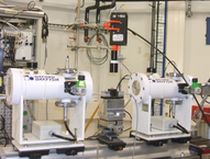 Oxford ionization chambers
Oxford ionization chambers
Fluorescence :
![]() Canberra 35-elements monolithic planar Ge pixel array detector
Canberra 35-elements monolithic planar Ge pixel array detector
 Detector Silicon Drift : Vortex
Detector Silicon Drift : Vortex
Total electron yield
No picture. The sample must be electrical conductor otherwise a thin layer of graphite may be evaporated.
Beam size using capillary : 75μm x 75μm
Application in Environmental science as an example, but also microfluidic application and grazing incidence of thin films.
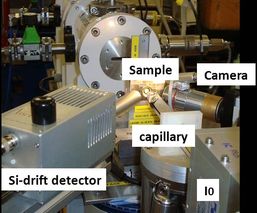
Quick-exafs Mode
Crystal type : Si311 Si111 (4 to 37 keV)
Beam size : typically 0.5 mm x 1 mm
Flux ~ 1011 ph/s at 8 keV
Detection
Transmission

Oken ionization chambers
Fluorescence
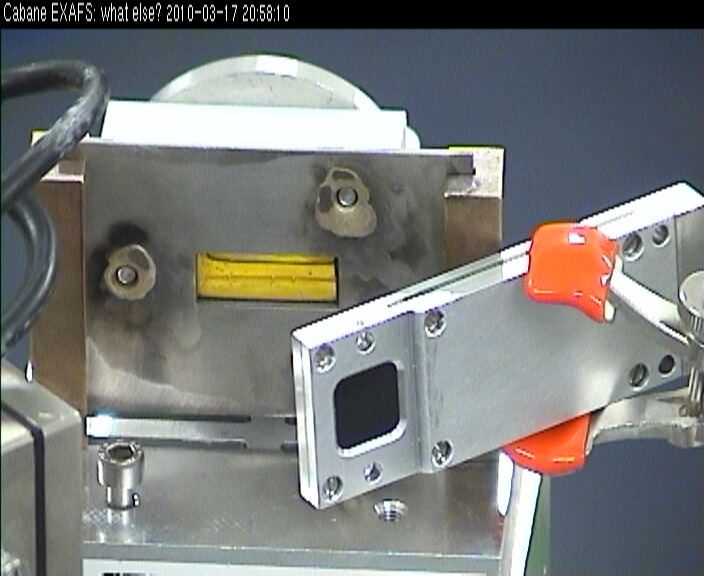
Avalanche Photo Diode (APD)
TEY
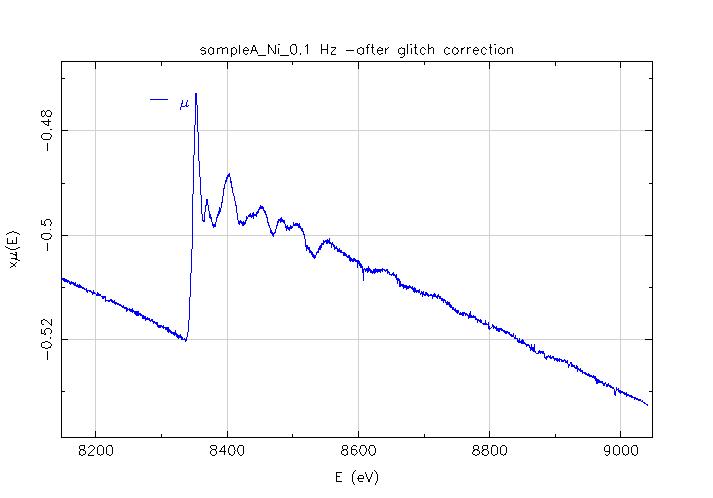
Tey absoption spectrum
Ni K edge XAS signal (up) collected in a TEY detection mode on a Proton Exchange Membrane Fuel Cell thick film in the Quick-EXAFS mode after correction of glitches. The presented spectrum is not averaged (5s of time acquisition).The frequency of oscillation of the Si(111) channel-cut was 0.1 Hz (5s per spectrum) with an oscillation amplitude of 1.6°.
No picture. The sample must be electrical conductor otherwise a thin layer of graphite may be evaporated.
Edge Jump
Large energie range from 4 keV (Si111) to 37 keV (Si311) in 30s
The remote selection of the monochromator crystals, Si(111) or Si(311), allowing users to permanently access energies between 4 and 37 keV in Quick-exafs mode.
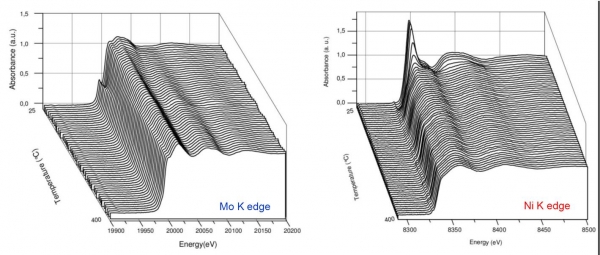
The SAMBA quick-EXAFS monochromator: XAS with edge jumping
E. Fonda, A. Rochet, M. Ribbens, S. Belin, V. Briois The SAMBA quick-EXAFS monochromator: XAS with edge jumping J. Synchrotron Rad. 2012, 19, 417 – 424.
Example of the energy range accessible with Si111 cam=4°
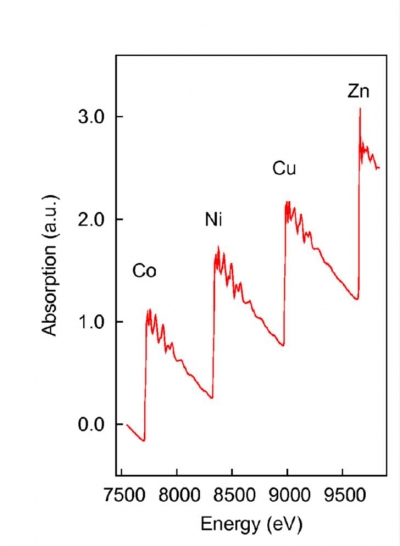
Notice :
CombinedTechniques
XAS with Raman spectroscopy
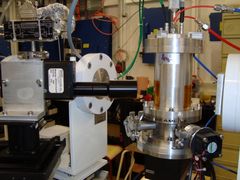
XAS with Raman spectroscopy
Kosi RXN1-785 Kaiser
Iexc. = 785 nm or 532 nm
CCD: 100-3450cm-1 or 200-4000 cm-1
Optical fibers
with probehead
Seceral Long Working Distance objectives (150 mm to 35 mm)
XAS with UV-visible spectroscopy
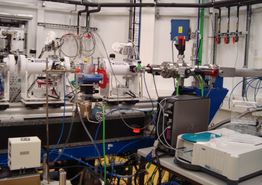 Cary 50 VARIAN
Cary 50 VARIAN
With optical fibers
190 < I < 1100 nm
VScan < 24000 nm/min
XAS cell with mylar or PP windows for optical fiber used in transmission
or immersion probe : 2 or 10 mm
or cuvettes Quartz, Glass, PMMA, PS
XAS with Raman and UV-Visible spectroscopies
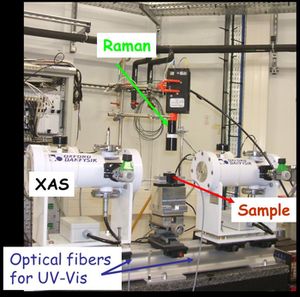
XAS with Differential Scanning Calorimeter (DSC)
DSC 111 Setaram :
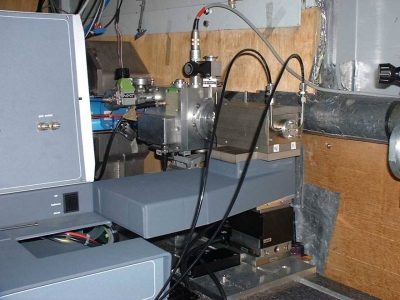 Calvet type differential scanning calorimeter
Calvet type differential scanning calorimeter
-120 to 800°C
* Phase transition (fusion, crystallization,
glass transition, polymerization, degradation)
* Cp Evaluation
* Monitoring of reactions
(oxidation, reduction, dehydration...)
Catalysis
Retrouvez ci-dessous les différents environnements échantillons catalyseurs à votre disposition sur la station EXAFS.
Polyvalent SOLEIL development for fluorescence, transmission and Raman coupling
La Fontaine, C., Barthe, L., Rochet, A., & Briois, V.
X-ray absorption spectroscopy and heterogeneous catalysis: Performances at the SOLEIL's SAMBA beamline.Catalysis Today, 2013, 205: 148–158
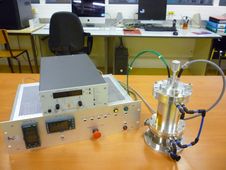
![]() Characteristics Lytle-type cell
Characteristics Lytle-type cell
- RT 600°C +/- 0.5°C
- Atmospheric pressure
- Powdered catalyst gently pressed into the cavity of the sample hoolder (thickness 2, 4 and 6 mm, 0.10 - 0.25 cm3)
High pressure cell for transmission and Raman coupling
A. Rochet et al. Catalysis Today (2011) vol 171 186-191
A. Rochet et al. Diamond Light Source Proceedings (2011) 1, e130 1-4
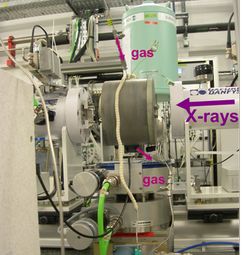
![]() Characteristics Lytle-type cell
Characteristics Lytle-type cell
- RT 600°C +/- 0.5°C
- 50 bar
- Powdered catalyst gently pressed into the cavity of the sample holder (thickness 2 mm)

![]()
Commercial cell Harrick for fluorescence and Raman coupling
C. La Fontaine et al. Harrick Scientific Products (Ed.), Application Note n°91201 (2010).

Characteristics
- RT 500°C
- Atmospheric pressure
- Powdered catalyst (≈50 mg) gently pressed into the sample holder cavity
- Catalyst pellet (6 mm dia.) disposed onto a BN bed
Gas distribution system
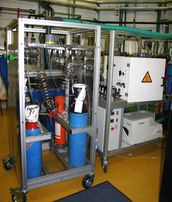
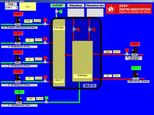
- Complex mixtures
- Saturator for liquid reactants
- Heated lines (120°C)
- Patm --> 20 bar
- Remote control
Mass spectrometer
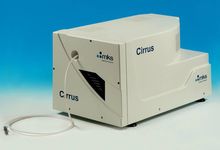 MKS Cirrus
MKS Cirrus
LM99 Analyser
- Tripple mass filter, 1-200amu or 1-300amu
- Faraday and SEM detector
- Maximum operating pressure Faraday 2x10-5 mBar
Energy Science
Setup for Li/Na batteries
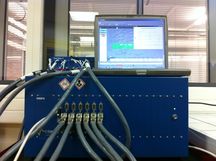
![]() VMP3 Bio-logic Multi-channel Potentiostat
VMP3 Bio-logic Multi-channel Potentiostat
16 independent channels, 6 already equipped whose one for impedance measurement

Low temperature
Helium Cryostat
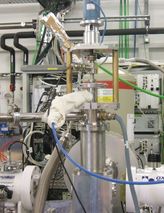
He cryostat suitable for transmission and fluorescence detection
(20 K to Room Temperature)
Nitrogen Cryostat
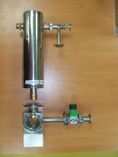 Liquid nitrogen (80 K) cryostat suitable for transmission and fluorescence detection
Liquid nitrogen (80 K) cryostat suitable for transmission and fluorescence detection
Liquid Cells
We have different cells with fixed or variable optical path available for basic or acidic solution. Two of them are thermostatically controlled. Note Kapton, Mylar, PP or PTFE can be used as windows depending of the nature of the solution.
Liquid cell with variable optical path for transmission
 Thermostated liquid cell (PTFE) with adjustable optical paths (10 µm to 6 mm) suitable for the combination of transmission XAS with UV-Vis spectroscopies (design SPECA)
Thermostated liquid cell (PTFE) with adjustable optical paths (10 µm to 6 mm) suitable for the combination of transmission XAS with UV-Vis spectroscopies (design SPECA)
Liquid cell for transmission
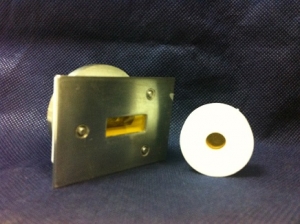 Liquid cells PTFE with fixed optical paths
Liquid cells PTFE with fixed optical paths
(0.5<o.p.<5mm)
Liquid cell for fluorescence mode
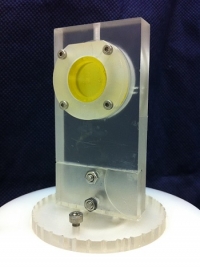 Liquid cell (PCTFE) for fluorescence detection
Liquid cell (PCTFE) for fluorescence detection
(design F. Villain)
Liquid cell for biological sample
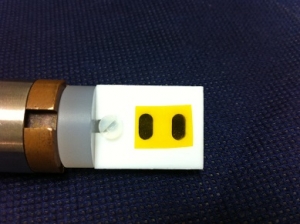 PTFE sample-holder for He cryostat
PTFE sample-holder for He cryostat
(two samples ~ 50µl) available for
transmission and fluorescence detection
Thermostated liquid cell
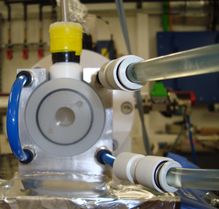 Thermostated liquid cell (PCTFE) with adjustable optical paths (100µm to 10mm) suitable for the combination of transmission XAS with Raman and/or UV-Vis spectroscopies
Thermostated liquid cell (PCTFE) with adjustable optical paths (100µm to 10mm) suitable for the combination of transmission XAS with Raman and/or UV-Vis spectroscopies
(design F. Villain)
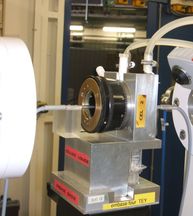 Thermostated liquid cell (PTFE) with adjustable optical paths (10µm to 6mm) suitable for the combination of transmission XAS with UV-Vis spectroscopies (design SPECA)
Thermostated liquid cell (PTFE) with adjustable optical paths (10µm to 6mm) suitable for the combination of transmission XAS with UV-Vis spectroscopies (design SPECA)
SEXAFS Hutch
Surface preparation and growing of thin films under UHV (10-10)
Tools for preparation
Knudsen cells, Source for
Omicron electron, Quartz balance
XAS detectors
Dinode (TEY), 7-elements Ge Canberra (fluorescence)
Surfaces caracterization
Auger, LEED, Quadrupole residual gas analyser
Note: The sample holder can be cooled down to -190°C and heated up to 1000°C (depending on the transferable holder type).
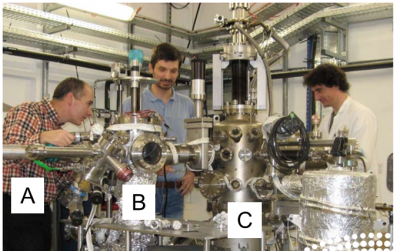
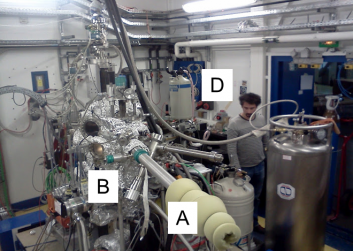
View of the UHV SEXAFS vessel:
(A) manipulator for transfer of samples;
(B) storage carrousel chamber;
(C) main analysis/growth chamber;
(D) 7 elements Ge detector (Canberra France)
Notices :
![]() gnuplothowto.pdf (114.69 KB)
gnuplothowto.pdf (114.69 KB)
![]() new_holderpositions.pdf (84.22 KB)
new_holderpositions.pdf (84.22 KB)
![]() sputteringhowto.pdf (62.75 KB)
sputteringhowto.pdf (62.75 KB)
![]() tbt_cryostats.pdf (54.91 KB)
tbt_cryostats.pdf (54.91 KB)
![]() augerhandbook.pdf (340.67 KB)
augerhandbook.pdf (340.67 KB)
Information for the users, help for preparation and submission of proposal.
Gas
The application for the use of specialty gases must be stipulated in your proposal in order that the security service can assess the associated risks. Specialty gases must be commanded 8 weeks before your experiment, also you have to prevent your local contact well in advance, for common gases (helium, argon, nitrogen, hydrogen, air and oxygen) only 2 weeks are sufficient.
Helium Liquid
The application for the use of helium liquid must be stipulated in your proposal and recalled to your local contact in such a way to order sufficiently in advance the suitable volume.
Sample positioning
Two schemas of implantation for new experimental set-up on the EXAFS table could be hold, but contact your local contact is mandatory.
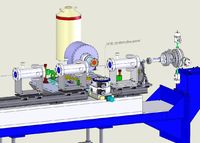
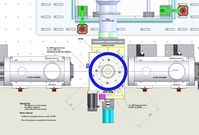
Aide à la soumission de projets
Beamtime Applications
Projects are examinated twice a year by an independant peer review commitee. The projects must be filled via the SunSet Application
Two important deadlines (standard & BAG project) :
15 February - 15 September
How to prepare your Beamtime application ?
Project must be written in english and submissions must comply to the following framework :
Online submission of the web form to give general information
1. Description of the scientific background and experimental part
2. Figures or images in annex (format .jpeg .png)
3. Description of experimental conditions with special safety measure
4. Submission of the proposal
(If the application constitutes the project continuation, filing in a report of the previous experiment in the SunSet and mention of related publications are necessary)
Also,
- It is strongly advised to contact one of the beamline scientist, they will assist in the definition of the setups necessary for the desired experiment and in the assessment of the best conditions.
- The justification of the required beamtime is required.
Do not forget to mention your related publications in the sunset.
For more informations : The general User's guide The general User's guide

